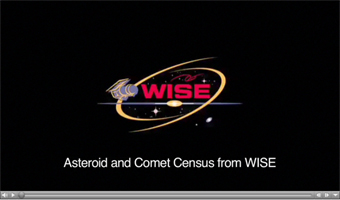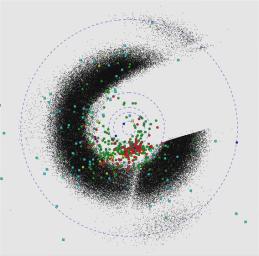
Click on the image for animationThis animation demonstrates how the Wide-field Infrared Survey Explorer, or WISE, surveys asteroids and comets in the solar system. The project to hunt for asteroids and comets -- including near-Earth objects, or NEOs -- using the WISE data is called NEOWISE.
The perspective shown here is looking down from high above Earth's North Pole, a kind of bird's eye view of the solar system. The planets are shown as blue dots, and their orbits are the dashed lines. Earth is the third blue dot from the sun. The big mass of black dots consists of asteroids in the main belt, between Mars and Jupiter.
The green dots show the known near-Earth objects, both asteroids and comets, that NEOWISE has spotted so far. Newfound near-Earth objects are shown as red dots. The turquoise squares are comets observed by the mission so far, and the yellow squares are newfound comets.
The animation covers the period from early January through mid-September, 2010. As of Oct. 4, 2010, the project has observed more than 150,000 main belt asteroids and discovered more than 33,500. It has observed 452 near-Earth objects and discovered 118. It has also observed 110 comets and discovered 19.
JPL manages the Wide-field Infrared Survey Explorer for NASA's Science Mission Directorate, Washington. The principal investigator, Edward Wright, is at UCLA. The mission was competitively selected under NASA's Explorers Program managed by the Goddard Space Flight Center, Greenbelt, Md. The science instrument was built by the Space Dynamics Laboratory, Logan, Utah, and the spacecraft was built by Ball Aerospace & Technologies Corp., Boulder, Colo. Science operations and data processing take place at the Infrared Processing and Analysis Center at the California Institute of Technology in Pasadena. Caltech manages JPL for NASA.
More information is online at http://www.nasa.gov/wise and http://wise.astro.ucla.edu.

 Planetary Data System
Planetary Data System













